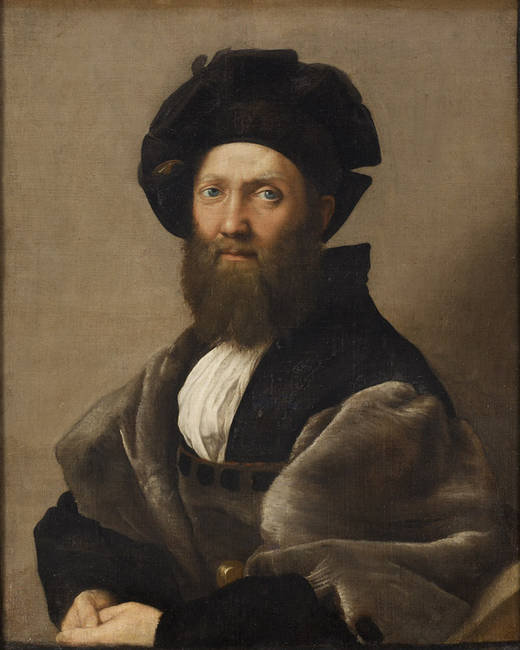Raffaello
dal 11/6/2012 al 15/9/2012
Segnalato da
Communications Department International Media Relations
11/6/2012
Raffaello
Prado Museum, Madrid
Late Raphael. The present exhibition aims to establish a clear definition of the boundaries between works executed by Raphael and those produced with the collaboration of his principal assistants, Giulio Romano and Gianfrancesco Penni.

Late Raphael, is one of the most important exhibitions ever to be devoted to the artist and his studio and the first to focus on his final years, during which time Raphael became the most influential painter in Western art. The exhibition includes a total of 74 works, the majority of them never previously exhibited in Spain. It presents a chronological survey of Raphael’s artistic activities from the start of the pontificate of Leo X (1513) to the artist’s death in 1520, as well as analyze the activities of his principal assistants, Giulio Romano and Gianfrancesco Penni, up to 1524.
Late Raphael is the first major survey exhibition on Raphael (Raffaello Sanzio, 1483-1520) to combine paintings and drawings in order to focus on the last seven years of the life of the artist, who died in Rome on his 37th birthday. This was the period in his career when Raphael produced the work that would have the greatest subsequent impact on European art. Nonetheless, his paintings have not been fully understood due to chronological issues, to their disconcerting diversity and because the artist did not work by himself.
The present exhibition aims to establish a clear definition of the boundaries between works executed by Raphael and those produced with the collaboration of his principal assistants, Giulio Romano (ca.1499-1546) and Gianfrancesco Penni (ca.1496-1528). It starts in 1513 by which date Raphael had been working in Rome for five years, decorating the monumental Vatican Stanze alongside other leading Italian artists such as Michelangelo (his principal rival, at that point working on the Sistine Chapel) and Sebastiano del Piombo, firstly during the pontificate of Julius II then for Leo X.
With the change of pope Raphael took on a greater number of commissions both for Leo X and for other patrons and at this point began to employ a considerable number of assistants. His studio was very possibly the largest to date under the direction of a single great painter and eventually counted on 50 pupils and assistants./p>
The exhibition presents the visitor with the highly efficient and effective results of this system, led by the remarkably versatile Raphael. In addition to producing easel paintings (the subject of this exhibition) he also executed frescoes such as those for the Vatican Stanze and for the Villa Farnesina, cartoons for tapestries (for the Sistine Chapel), and worked as an architect (continuing the construction of St Peter’s after Bramante’s death).
The exhibition includes an unprecedented selection of forty-four paintings, twenty eight drawings, an archaeological item and a tapestry, loaned from around forty different institutions. Visitors can see a chronologically structured survey organised into six sections that cover Raphael’s pictorial and aesthetic evolution and also presents a comparison of his final style with a group of works by his two assistants Romano and Penni, the latter produced both during Raphael’s lifetime and immediately after his death. This unprecedented opportunity for comparison allow for an identification of the degree of participation of Raphael and his assistants in these works while also helps to establish the latter’s intellectual and aesthetic contribution to Raphael’s oeuvre.
In this regard the almost thirty drawings that are displayed alongside the paintings play a key role in helping to identify Raphael’s hand, not only due to their absolute mastery but also because they reveal the original design and conception of his paintings.
Among the most outstanding works that have travelled to Spain for the first time are the serene portrait of one of the artist’s friends, Baldassare Castiglione (1519), loaned from the Louvre, and the major altar painting of Saint Cecilia (1515-1516) loaned from the Pinacoteca Nazionale de Bolonia in which the viewer can appreciate the remarkable beauty of the figures and their perfect, harmonious composition, a level of achievement that Raphael attained during his time in Rome.
Also remarkable are the paintings from Raphael’s late period in the Prado’s own collection, including the panel transferred to canvas known as Lo Spasimo di Sicilia (1515-1516), which is on display for the first time since its restoration.
Image: Portrait of Baldassare Castiglione, Raphael. Oil on panel, 82 x 67 cm. Paris, Musée du Louvre, Département des Peintures © 2007 Musée du Louvre / Angèle Dequie
Press contact:
T: +34 913 30 29 60 / 41 F: +34 913 30 28 58 maria.pena@museodelprado.es - elena.garrido@museodelprado.es
Prado Museum
calle Ruiz de Alarcón, 23 28014 Madrid. España
Opening hours:
From Tuesday to Sunday: 9am – 8pm (including holidays)
Closed: On Mondays throughout the year (including holidays) and January 1, Good Friday, and December 25.
Reduced opening hours 9am – 2pm: January 6, December 24 and 31.
Ticket price:
General: 10 €
General admission + official guide: 19.50 €
Reduced: 5 €
This ticket allows the holder to visit the museum collection and temporary exhibitions on the same day



